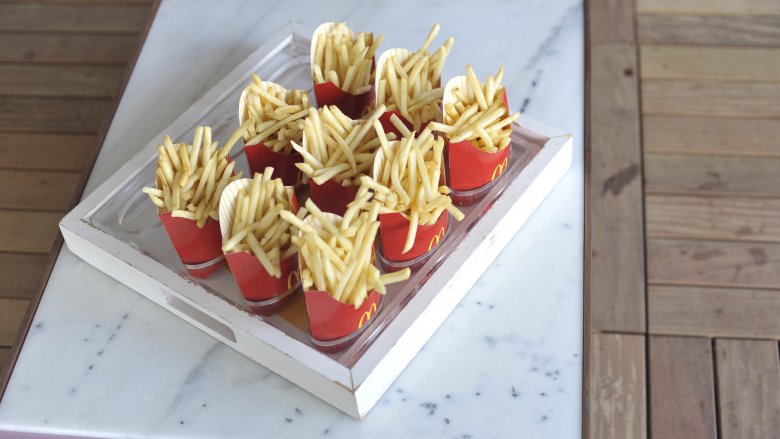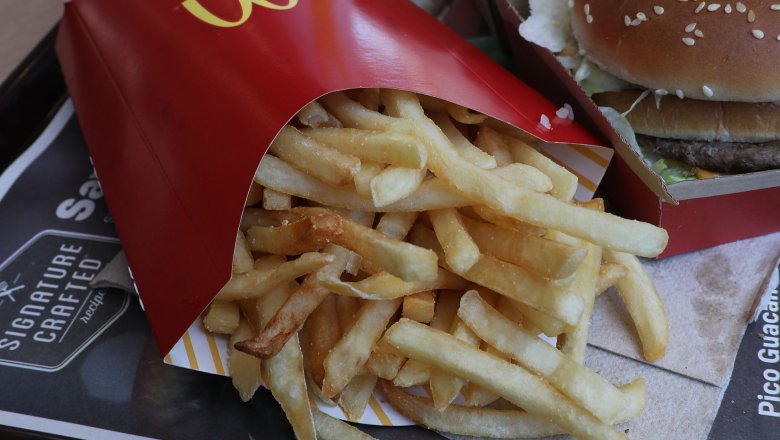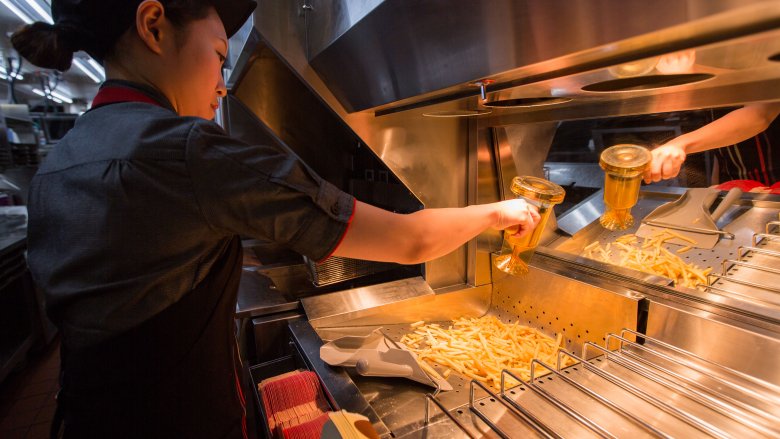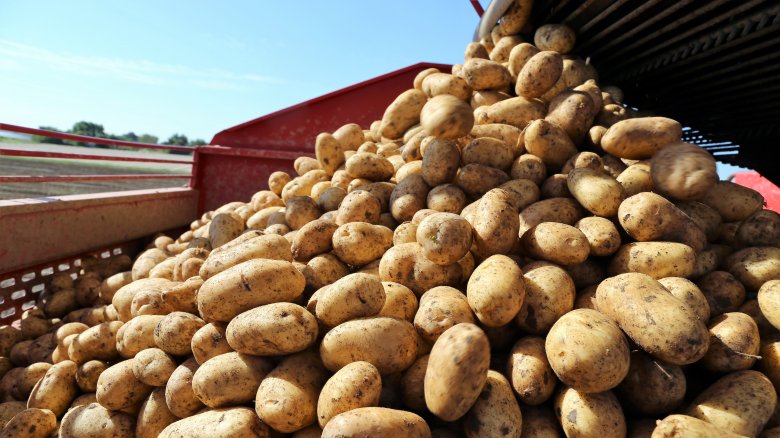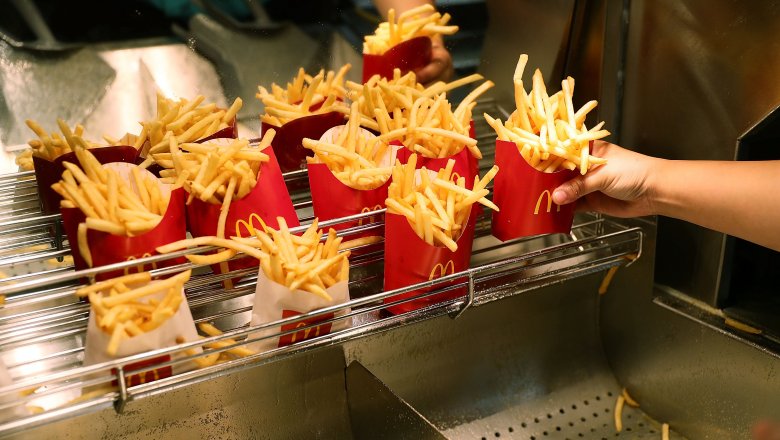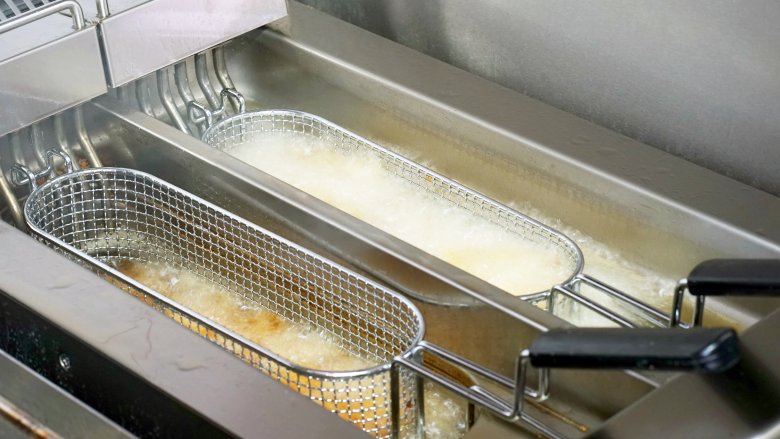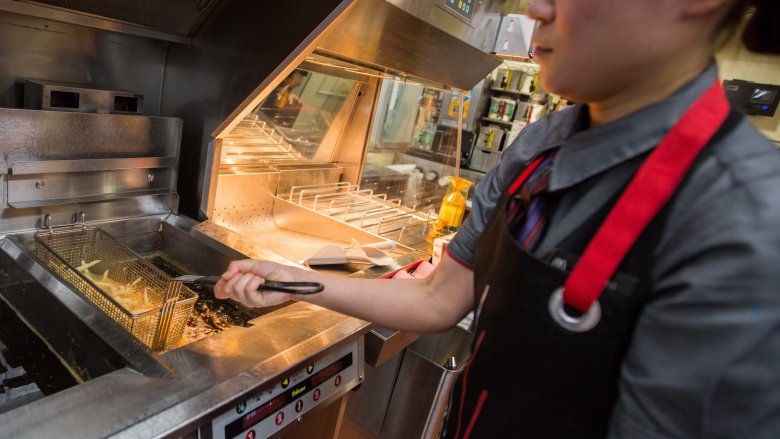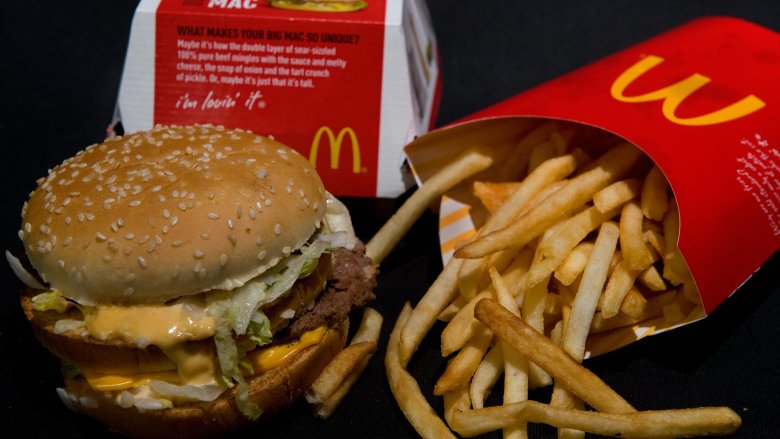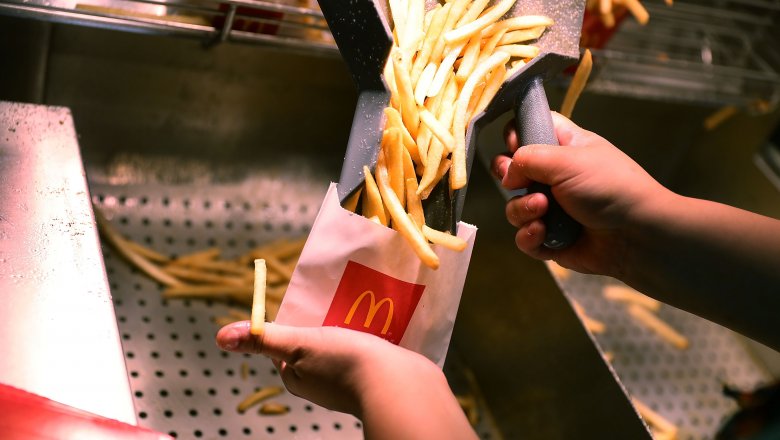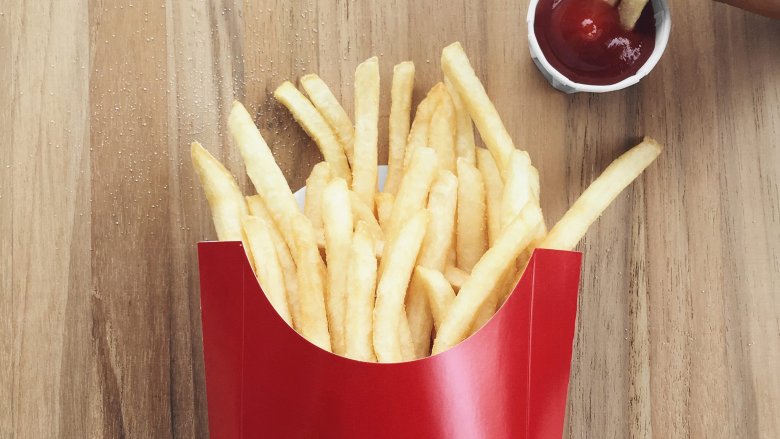This Is Why McDonald's Fries Are So Delicious
It's a run-of-the-mill Saturday afternoon. You're out running your dumb grown-up errands: A stop at the home improvement store for an antibacterial toilet brush, maybe, or a quick run into the pharmacy to load up on cherry-flavored antacids. You know, real adult-type stuff. To celebrate, you decide to treat yourself to a spin through the McDonald's drive-thru, when you hear the most perfect phrase ever to come spilling out of a tinny drive-thru speaker. "Could you pull up to the yellow line?" the speaker bleats incoherently, "It's going to just be a few minutes."
Sure, it's a minor inconvenience, a tiny speed bump in an otherwise super-efficient lunchtime feeding system for millions of people each day. Waiting even an extra few minutes, when what you want is a burger, and when you want it is now, seems like a real injustice. But you also know that the extra few minutes you have to patiently wait means that something wasn't quite ready yet inside the hyper-efficient McDonald's kitchen, and that usually means you're in for a batch of piping hot, fresh-from-the-fryer McDonald's french fries.
That red and yellow cardboard sleeve. Those perfectly-cooked, golden shoestrings of fluffy, starchy potato. That one-two combo punch of sugar and salt. When McDonald's french fries are bad, they're still pretty good, and when they're good, they're extraordinary. But what exactly is it that makes McDonald's fries so perfectly craveable, so addictively munchable, time after time, visit after visit? We decided to find out.
The artificial beef flavoring in the fry oil
The rumors are true. There's beef in the french fries from McDonald's.
Okay, well maybe not exactly true. McDonald's fries may not contain any actual beef, but one of the added ingredients that contributes to their uniquely addictive quality is natural beef flavoring. The mysterious ingredient can be traced back to the 1950s, when the company that supplied fryer oil to the McDonald's corporation suddenly found itself in a bit of a pickle; they weren't able to keep up with demand for hydrogenated oil, which required costly specialized equipment. So they did what anyone with an entrepreneurial, can-do attitude would do in such a crisis situation: They started adding beef tallow to vegetable oil, crossed their fingers, and hoped for the best.
The beefy flavored fries became a bestseller at McDonald's, until more health-conscious consumers in the 1980s began to question the wisdom of frying potatoes in cow fat, from a "not dying of arterial blockage" perspective. Pressure mounted for the chain to switch to an all-vegetable oil solution for their endlessly burbling fryers, but by then, customers had grown so accustomed to those uniquely bovine flavor notes that McDonald's began supplementing the oil with an all-natural beef flavoring, made from hydrolyzed milk and hydrolyzed wheat, which produces that familiar meaty taste. Unfortunately for vegans, the milk content makes McDonald's french fries non-vegan compliant, but fortunately for the rest of us, it also makes them amazing.
Two words: Sugar and salt
Ever notice the way that sometimes, when you're eating certain foods, some kind of primal response takes over in the farthest corners of your hunter/gatherer brain, and you can't stop eating until you've consumed the entire bag/box/trough of that particular food? When that kind of survival instinct kicks in, it's probably due to two things: Sugar and salt.
We humans are fairly well addicted to both these magical ingredients, and sugar has even been likened to a drug. Cassie Bjork, R.D., L.D., told Healthline, "Research shows that sugar can be even more addicting than cocaine. Sugar activates the opiate receptors in our brain and affects the reward center, which leads to compulsive behavior, despite the negative consequences like weight gain, headaches, hormone imbalances, and more."
McDonald's fries capitalize on this primal desire perfectly, combining both of these flavors in one perfect snack. McDonald's coats their fries in dextrose (a form of sugar) to make them more consistent in their golden brown appearance, and then pounds them with salt when they are pulled from the fryer. When salt and sugar are combined in this sort of balanced equilibrium, our dumb lizard brains flood with dopamine, the neurotransmitter that produces feelings of pleasure, and our willpower can't hope to compete.
They use real potatoes
If you've ever let your mind wander down the mental corridors of the perfection of McDonald's french fries, you may have assumed that some sort of advanced food engineering was in play. After all, when the manufacturers of Pringles decided they wanted their pizza-flavored chips to stack neatly into a can, they didn't start with raw potatoes, they shaped them out of a reconstituted mash of potato flakes, using a mixture of food science and pure magic. Wouldn't it be safe to assume that McDonald's was up to some similar shenanigans with its french fries?
Though it may be hard to believe when you crack into another carton of perfectly cut-and-shaped McDonald's french fries, every batch does, in fact, start with real, whole potatoes, including Russet Burbank and Shepody varieties. The potatoes are skinned, washed, and then fired at impossible velocities of up to 70 miles per hour through a knife-filled tube, which cuts and shapes the humble spuds into those familiar shoestring shapes. The cut fries are par-cooked, and then flash-frozen and shipped to stores, where they get finished cooking and covered in delicious, life-giving salt.
Maybe fries made with reconstituted potato mash would taste fine, but we can't help but think that those real potatoes go a long way in making McDonald's french fries taste so good.
They're visually perfect
A food's appearance can be a major factor in how delicious we think it is, which is why many of us tend to prefer a fussy summer salad made with fresh spinach and sautéed crispy shallots, drizzled with raspberry vinaigrette, and festooned with a parade of slivered toasted almonds and dried cranberries to, say, a dingy white PVC bucket filled with pig's ears. Yes, appearance goes a long way when it comes to making foods craveable and desirable, and McDonald's goes to great lengths to make sure that every batch of fries is as close to visual perfection as scientifically possible.
The process starts right after the potatoes are precisely cut; the raw french fries are pushed through a blancher, which strips them of their natural sugars before being coated in dextrose, a corn-derived sugar, which factory workers say ensures "a consistent color no matter what time of the year it is." Next, the fries are coated in sodium acid pyrophosphate, which keeps the fries from turning gray after freezing and help ensure a consistent pale yellow color, batch after batch. Nobody wants gray french fries, no matter how delicious they are.
Delicious fats
Though McDonald's stopped using trans fats in its french fries way back in 2008, for a long time, the signature flavor of partially hydrogenated vegetable oil had a lot to do with the deliciousness of their french fries.
McDonald's had been using partially hydrogenated vegetable oil in its fryers for years, in part because the chemical process of adding hydrogen to the oil helped to extend its shelf life (and changing the fryer oil less frequently means more profit for the company). But this hydrogenation process also creates trans fats, which according to an article at the time by NPR, were "as bad for you, and possibly worse, than the saturated fats they replaced. Trans fats not only raise bad cholesterol levels, which increase the risk of coronary heart disease, but lower good cholesterol levels as well."
The problem that the company faced in the 2000s, however, was that trans fats tended to make things more delicious. According to a company representative at the time, when McDonald's fries don't taste quite right, "It's the minor components of hydrogenation that [were] imparting the flavor. So [customers] really want 'hydro flavor' in their product."
After experimenting with 18 different types of fryer oil, the McDonald's corporation settled on a "high oleic canola oil," which has the lowest levels of saturated fat in the vegetable oil family, zero trans fats, and longer life in those hard-working fryers, all without sacrificing flavor.
MSG is created in the cooking process
When the McDonald's corporation made the decision to add artificial beef flavoring to their fry oil, in an effort to mimic the beef tallowy-goodness of the 1950s recipe, they created another chemical component that contributes to the addictive quality of their French fries: MSG.
The natural beef flavoring McDonald's uses in its recipe is made mostly from hydrolyzed wheat and hydrolyzed milk, which for reasons better explained by hardcore food scientists, closely resembles the taste of beef. But here's the thing: When these ingredients hit the bubbling hot oil of the fryers, they start to break down, creating naturally-occurring monosodium glutamate, or MSG, in the process.
The consumption of MSG has been accused of everything from weight gain to headaches to weird allergy-like reactions, side effects that have been almost entirely debunked. The fact is, MSG isn't in and of itself a bad thing; naturally-occurring glutamate (chemically identical to MSG) is in plenty of foods, including Parmesan cheese, green peas, and tomatoes, and lends a savory, umami-rich flavor to protein-packed foods. It also happens to interfere with the satiation mechanism in our brains, and has been proven in some studies to increase overall food intake in laboratory animals.
The next time you find yourself unable to stop eating McDonald's french fries, stuffing your happy tum-tum well past the point of fullness, it may not be the fries themselves; it may be all of that magical, flavor-enhancing MSG.
The thin cut
French fries come in dozens of unique shapes, sizes, and flavors, from the seasoned curly fries at Arby's, to the frozen crinkle-cuts your mom probably made on burger night, to that hot tangle of county fair chaos that you eat out of a paper cup with a tiny wooden fork.
But there's a reason the thin-cut McDonald's fry has emerged as the king of french fries. Measuring no more than a quarter-inch across, they represent the perfect balance between golden, crispy outside, and fluffy, baked potato inside; any thinner, and french fries turn into nests of too-crunchy mouth-destroying coating, totally devoid of any starchy potato goodness. Any thicker, as in a so-called "steak fry," and the crispy element is lost, resulting in a french fry that has more in common with a baked potato, and not in a good way.
According to The New York Times, the thin-cut McDonald's-style French fry represents the perfect balance; a fry that can "emerge with enough crispness to stand up to a cheeseburger, enough taste to go with a lobster roll, and the right stuff to stand proud on its own."
They're one of the original menu items
In 2016, The Daily Meal shared a photo of the original McDonald's menu from the 1950s, when the restaurant chain was in its infancy. There weren't any 20-piece boxes of McNuggets, the Filet-O-Fish was nowhere to be found, and the Sausage McGriddle didn't exist on even an imaginary level yet. Over sixty years ago, a trip to McDonald's meant you could get a hamburger, you could get a cheeseburger, or you could get an order of "Golden French Fries" for a dime, making the now-legendary McDonald's fry one of the original menu items.
Actually, fries at McDonald's go back even farther than that, all the way to the company's origins as a barbecue restaurant, when the McDonald's brothers focused on ribs and pork sandwiches. Even then, fries were a staple offering for the restaurant.
And here's the thing: When you devote yourself to doing one thing for almost 80 years, whether that's riding a unicycle, speaking Mandarin Chinese, or playing Mike Tyson's Punch-Out, you get really, really good at it. McDonald's owes some of the perfection of its signature creation to one thing: Lots and lots of practice.
They're the most popular item on the menu, so there's high turnover
While the food scientists at McDonald's are constantly trying to innovate and overhaul their menu, it's their classic items that tend to sell the best, accounting for more than 75 percent of overall sales. And there's no item in the classic McDonald's lineup more popular than the french fry. In fact, the company sells approximately 9 million pounds worldwide, each and every single day. This makes McDonald's the number one purchaser of potatoes in the United States, where the company buys 3.4 billion (with a "b") pounds of potatoes, each and every year.
How does this insane volume contribute to the overall deliciousness of McDonald's french fries? It all comes down to turnover. Because the McDonald's corporation sells 6,250 pounds of french fries every single minute (assuming they were slinging fries 24 hours a day), the chances are high that when you cruise into your local franchise location at noon on a Saturday, fresh batches of the chain's spuds are being cooked up and sent out as quickly as the speed of the fryers will allow, ensuring that your order hasn't had a chance to sit around too long. Because french fries are one of the few menu items that nearly every customer orders, there's almost always a fresh batch on the way.
They're best consumed within five minutes
Is there a single menu item at McDonald's that suffers more, in terms of deliciousness, in the brief window between when they're pulled from the fryer and when they hit your mouth? What starts as a cardboard container representing the pinnacle of mankind's achievement in the fast food realm quickly turns into a mushy, mealy, limp pile of garbage in mere minutes.
McDonald's claims that after the fries get pulled from the fryer, they are held on warming tables for just seven minutes, before they are discarded and a new batch gets fried. When business is booming that may be true. But as anyone who's tasted the cold, sour sting of fries served past their prime can attest, that guideline might not always be adhered to if there's been a lull in customers. And besides, even seven minutes may be too long to wait, in the life of a McDonald's french fry. An exhaustive test by The Takeout revealed that McDonald's fries transformed themselves from crispy, golden spears of deep-fried perfection to grease-sodden sleeves of inedible trash in as few as five minutes.
Reddit users would have you believe that the trick to scoring fresh french fries is in ordering them "without salt," but all that does is guarantee that you'll get fries that need salt, while screwing up the line in the kitchen in the process. Instead, just ask for a fresh batch, and wait a few extra minutes. After all, when you can score a just-cooked batch of McDonald's fries, there are few things better on planet Earth.
